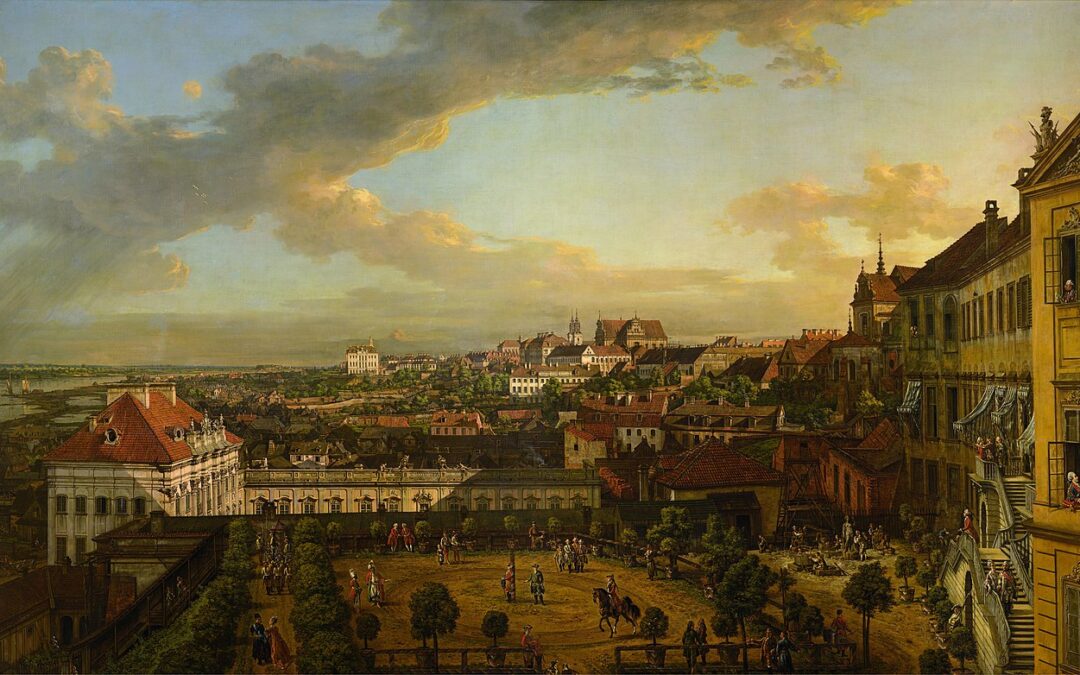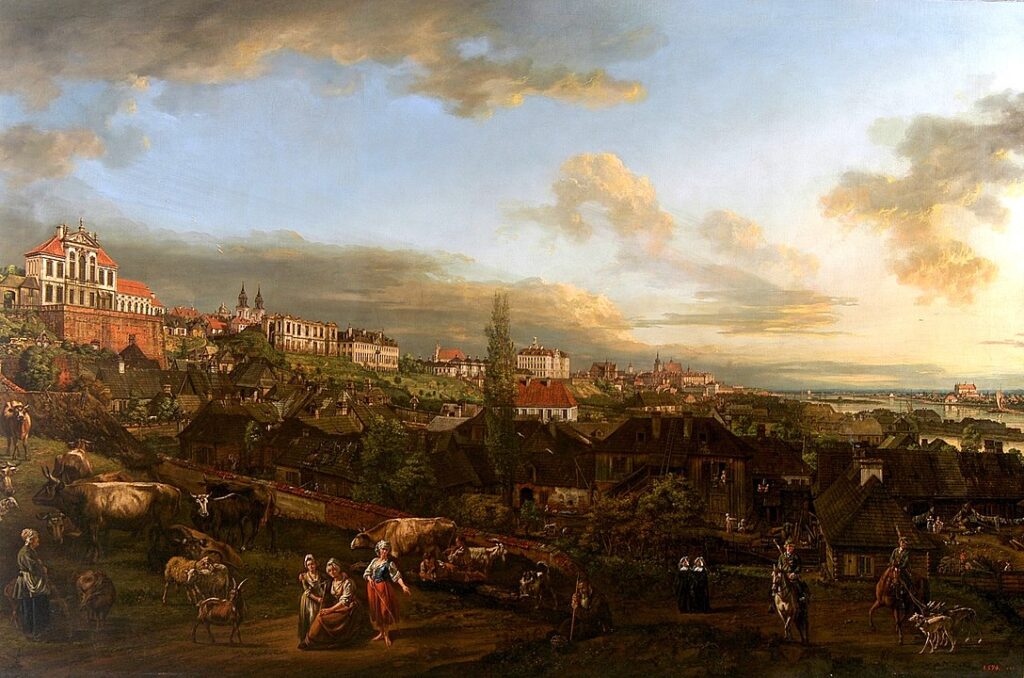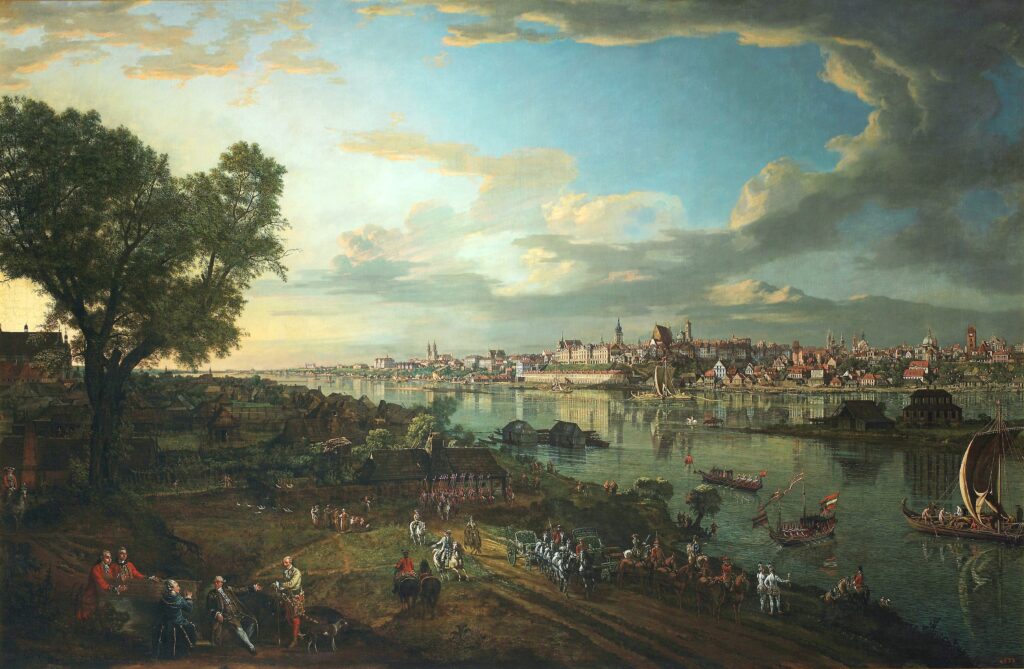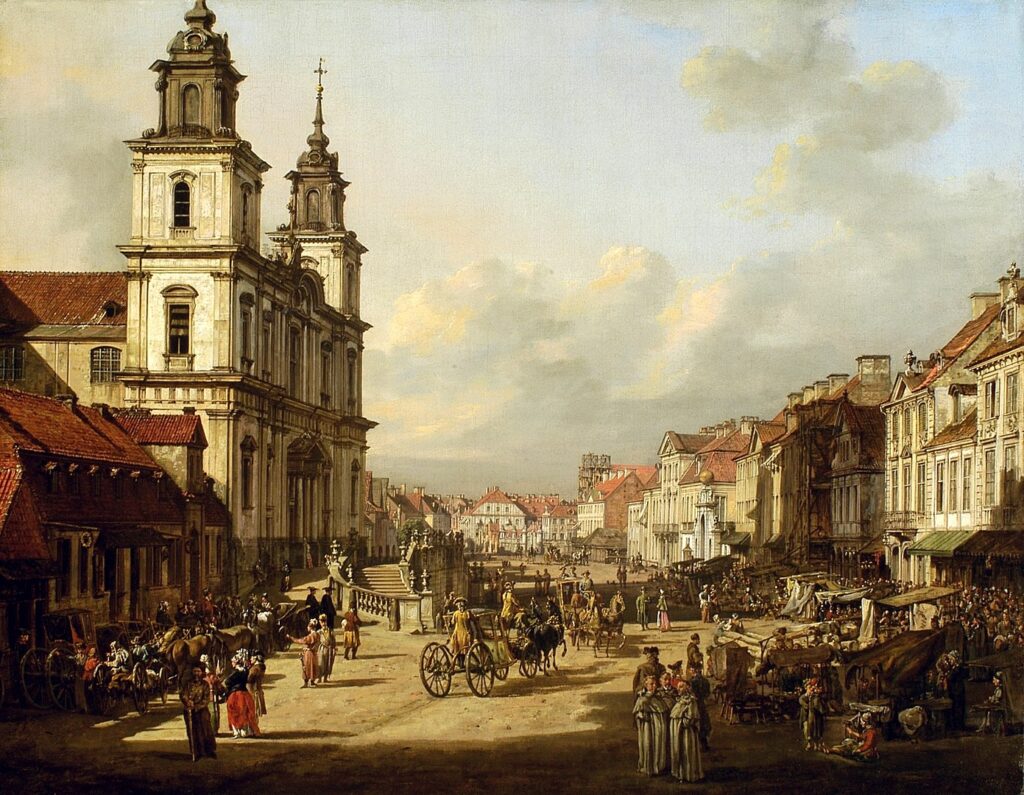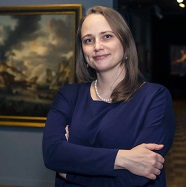By Aleksandra Janiszewska-Cardone (artykuł dostępny również w języku polskim)
A new exhibition presenting the works of Bernardo Bellotto, in Poland also known as Canaletto, can be visited at Warsaw’s Royal Castle between 23 September 2022 and 10 January 2023, marking the 300th anniversary of the painter’s birth. The castle’s permanent collection already displays many of the artist’s vedutas, or landscapes depicting the city.
Bellotto’s 18th-century vistas are literally part of Warsaw’s urban tissue, for it was to these remarkably detailed paintings that the rebuilders of the city destroyed in the Second World War turned for evidence of how it had once looked, and would soon look again.
The effect is stunning. Tourists visiting the heart of historic Warsaw today – the Old and New Towns and the so-called Royal Route formed by Krakowskie Przedmieście and Nowy Świat streets – can be forgiven for succumbing to the illusion that what they are seeing is the capital’s original centuries-old fabric.
Rebuilding Warsaw
Warsaw’s historic centre is “the sum of less or more accurate reconstructions of the structures that once stood in this city and new buildings that convey the atmosphere of the places and streets as architects understood, remembered or wanted to remember them”, as Małgorzata Omilanowska, a Polish art historian and former minister of culture and national heritage, poetically put it.
“It is the emanation of the dream of a generation of architects experiencing the trauma of war, who built the Warsaw they wanted to love and believed that its residents desired one like it.”
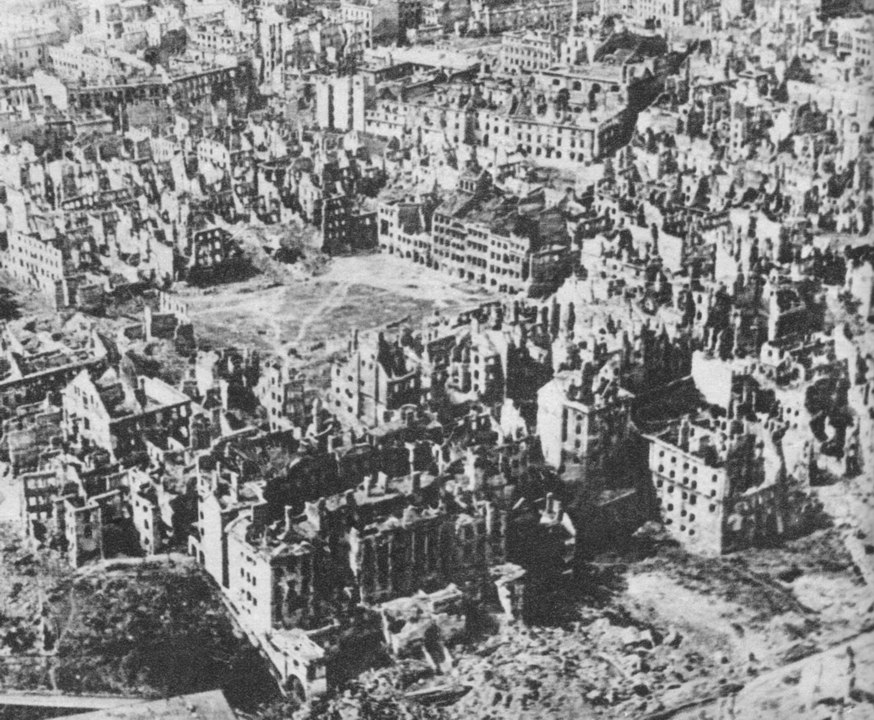
Warsaw’s destroyed Old Town, January 1945 (photo: M.Świerczyński (Wikimedia/public domain))
The Second World War was extremely destructive for Poland’s capital. As a result of the war – both the September campaign of 1939 and the occupier’s repressions after stifling the Warsaw Uprising in 1944, 75% of the city’s buildings were ultimately destroyed. The task of taking stock of the surviving structure and coordinating the building of new ones was handled by the Capital City Reconstruction Office (BOS).
One of its founders, Józef Sigalin, encountered an unexpected ally when preparing the plans to rebuild the Old and New Cities. The documentation prepared for presentation to the Soviet delegation in October 1945 included five photographs of Bellotto’s paintings as materials for reconstruction of the historic district, Sigalin revealed in his memoirs.
How did the urban landscapes painted by a Venetian artist in the 1770s gain such trust among the builders of postwar Warsaw?
Warsaw wouldn't look the same without #Canaletto. His paintings helped us rebuild the city after World War II. A huge #Bellotto300 exhibition at @Zamek_Krolewski is coming in September. Stay tuned!
Meanwhile, watch this documentary by @ARTEfr ❤️
➡️ https://t.co/g4nfwzsHKW ⬅️ pic.twitter.com/duhhadWXWu— Go2Warsaw (@Go2Warsaw) June 10, 2022
The flourishing 18th-century capital
Bernardo Bellotto, who also called himself Canaletto after his illustrious uncle Antonio Canal, arrived in Warsaw in 1767. At the time, the city was flourishing after the damages caused by war in the previous century, including the Swedish invasions.
Among the key factors in this development were the sejms taking place there – assemblies of magnates and the landed gentry at which various resolutions were voted on, with the city and its suburbs filling up with guests and their servants.
The richest of them built opulent palaces in the capital so they would not need to find lodgings for their visits. Even more importantly, after the election of Stanisław II August as Polish king in 1764, Warsaw again became the de facto royal residence. Although Sigismund (Zygmunt) III Waza had moved the capital there from Kraków in 1596, subsequent rulers had preferred to base their courts elsewhere – John (Jan) III Sobieski was happiest to reside in Wilanów, while the kings of the Saxon dynasty tended to stay in Dresden.
Stanisław August’s rule, therefore, heralded a revival for both the city and the royal castle as seat of the supreme state rulers. Although the times of the monarch’s rule were tragic in political terms, they brought renewal of intellectual as well as artistic and cultural life.
The king supported scholars, writers and artists, holding meetings in which they participated (so-called Thursday lunches) in the manner of French literary salons. His patronage nurtured the development of education and modern civic attitudes, as well as contributing to the blossoming of art and architecture.
Stanisław August was well educated and knowledgeable about French art and had an excellent understanding of painting’s political and civic role and potential for propaganda. He planned to open a European-style academy in Warsaw guaranteeing artists social advancement and inclusion in the liberal arts circle.
Unfortunately, these plans came to nothing. But Warsaw did gain from the presence of foreigners invited to the court, such as Marcello Bacciarelli, Jean-Baptiste Pillement, Josef Grassi, Johann Baptist von Lampi the Elder, and Bellotto himself. The proposed fine arts academy was replaced by the Royal Painting Studio (Malarnia) at the Royal Castle, established in 1766 and run by Bacciarelli.
Numerous Polish artists were educated in the studio. The king granted the most talented painters scholarships to Rome, Paris and Dresden. Aleksander Kucharski, Anna Rajecka and Franciszek Smuglewicz were among those to benefit from his generosity. As art historian Izabela Zychowicz put it, “today’s art in Poland would not exist without the Painting Studio and Stanisław August’s actions in the 18th century”.
Bernardo Bellotto stood out among the foreigners working in Poland for his unique talent in capturing city views. Originally from Venice, where he studied with his uncle, he perfected his skills working in Rome and then in Dresden, Vienna and Munich.
He spent the last 13 years of his life in Warsaw, working for the Polish king and changing the face of art there. Among other works Stanisław August commissioned from Bellotto were 22 vistas presenting the most important points of the capital of the Polish–Lithuanian Commonwealth, intended to decorate one of the rooms in the Royal Palace, where they still hang today.
Although this series came about from “the idea to perpetuate the most important architectural investments of the king himself and the families related to him”, as Omilanowska notes, its significance went much further. Firstly, the series made Warsaw as interesting a theme as other European metropolises “portrayed” by eminent vedutistas, such as Venice and Rome.
With Bellotto’s paintings collected in one room, for the first time the viewer could be in several places in the capital at once and admire its major sites or spectacular structures. This value was soon recognised by contemporaries such as Count Michał Jerzy Mniszech, who commissioned the artist Zygmunt Vogel to copy all the vedutas in watercolour.
Warsaw’s urban fabric and city life
Undoubtedly the most impressive painting is View of Warsaw from Praga, which depicts a panorama of the capital as seen from the eastern bank of the Vistula river. From the right, the buildings of the New Town are visible, among which the Gothic tower of the Church of the Visitation of the Most Blessed Virgin Mary and the dome of the Church of the Holy Sacrament of St Kazimierz can be identified.
Further we see the towers of the churches on Freta and Długa streets (the Dominican, Pauline and Piarists), and to their left is the Marshal’s Gate.
Further still, the painting depicts the tenements of the Old Town, with the tower and dome of the Jesuit Church emerging behind them and next to these the roof of St John’s collegiate church, today an archicathedral.
The central section of the panorama is dominated by the Royal Castle and Lubomirski Palace (today known as the Copper-Roof Palace), to the left of which one can see buildings flanking Krakowskie Przedmieście: St Anne’s Church, the Carmelite Church, the Ostrogski Palace on Tamka Street (which now houses the Fryderyk Chopin Museum), and Ujazdów Castle with its four corner towers (nowadays the home of the Centre for Contemporary Art).
Even today, all these buildings feature among Warsaw’s top attractions, with thousands of tourists visiting them every day.
Yet it was not just Warsaw’s urban fabric that was immortalised by Canaletto’s vistas, but also the daily life and customs of the 18th-century capital’s residents. Representatives of all estates poured into the city, from wealthy magnates seeking an audience with the king and the nobility with their servants to representatives of the bourgeoisie trying to make a living. They were all depicted by Canaletto in his scenes of life in the capital.
Figures in traditional Polish garb – a long robe known as a kontusz girded by Slutsk sashes, with halfshaven heads and high boots – are joined on the streets by characters in cosmopolitan French costumes, with powdered wigs and elegant shoes. Alongside grand squares and imposing buildings, Bellotto’s paintings depict views of the impoverished Powiśle district and passers-by busy with their everyday tasks.
The vistas were painted using a camera obscura – an optical device that was the forerunner of later cameras. This produced a reflection of the observed space, although to perpetuate the picture it was necessary to trace over the contours.
Using this machine gave the illusion of an accurate, distortion-free reproduction of reality. This is why Canaletto’s landscapes were regarded as faithful, almost photographic images of Warsaw’s appearance from the time of Stanisław August.
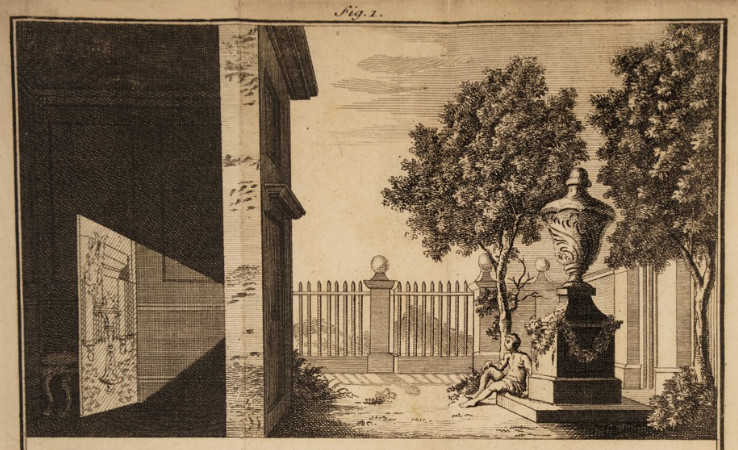
Illustration of the camera obscura principle from James Ayscough’s A short account of the eye and nature of vision (1755 fourth edition)
Tymoteusz Sawicki wrote in 1927 that these “architectural paintings are becoming the only accurate documentation of the expression of the 18th-century capital”, although he was aware of certain liberties the artist had taken in the composition of his paintings.
Like any artist, Canaletto composed the vedutas to give the best effect. This meant disrupting the perspective, spatial relationships or appearance of specific buildings if this could make the composition more expressive.
“The vision of Warsaw created by Canaletto is fascinating and extremely alluring,” writes Omilanowska. “Its perfection in conveying details, the clarity of the blocks of the buildings depicted and the captivating perspectives created a cohesive picture of the capital at the time of Stanisław, and for many the extent to which this painting is ‘amended’, ‘corrected’ or ‘idealised’ is unimportant.”
The hidden potential in Canaletto’s paintings was noticed more than ever in 1945, when the BOS members faced the extremely difficult task of rebuilding the city’s fabric. The pictures were particularly useful in reconstructing the Late Baroque forms of such buildings as the Church of the Holy Sacrament and the tenement houses on the New Town Square, Castle Square and Krakowskie Przedmieście.
The reconstruction of the Branicki Palace on Miodowa Street, near Castle Square, provides an interesting anecdote. The lizards and banana-eating gorilla that adorn its roof today were never part of the original decoration of the building, but did feature on Canaletto’s painting. The maestro no doubt added them to make the composition more picturesque, and this detail remained in the post-war reconstruction.
“The documentary value of Bellotto’s views in his work of restoration was incalculable,” wrote Stefan Kozakiewicz, the author of a monograph on the artist’s works. “They made possible the reconstruction of whole areas of the town as well as individual architectural monuments and as a result there are some parts of Warsaw which look today exactly as they do in his paintings.”
Evidence of this can be found at every turn, with information boards outside historic buildings showing the reproductions of paintings. And the original paintings themselves can also be seen at the Royal Castle in the room they were initially intended for.
#Bellotto300
🔔Niecierpliwie czekamy na tę wystawę. Ruszyła już przedsprzedaż biletów w promocyjnej cenie:
🎫 normalny 30 zł, ulgowy 20 zł
👉Dostępne w kasie Zamku i online:https://t.co/k914ck2r7p
Tylko do końca sierpnia!📍 "Bernardo Bellotto. W 300. rocznicę urodzin malarza" pic.twitter.com/D50EtDvIKX
— Zamek Królewski w Warszawie – Muzeum (@Zamek_Krolewski) August 3, 2022
Translated by Ben Koschalka. Main image: Bernardo Bellotto, View of Warsaw from the Royal Castle, 1773 (Wikimedia/public domain)
